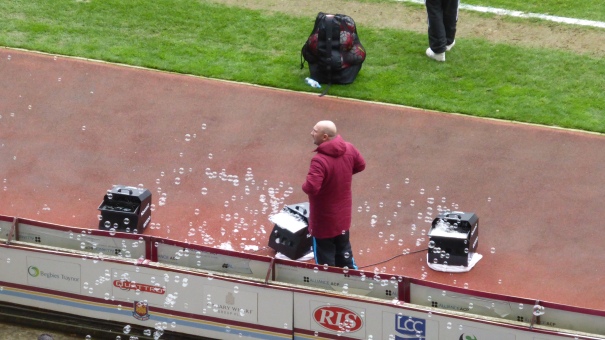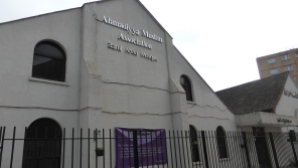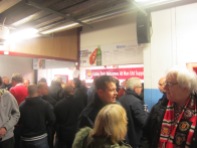
On Tuesday 10th May, West Ham United played their last ever league match at the Boleyn Ground by Upton Park. Next season they will move to the Olympic Stadium. I didn’t go to that match. But I went four weeks before for the ‘dress rehearsal’, the last FACup match at the ground – also against Manchester United. And, in fact, 4 days before that for the last London derby against Arsenal. All photos on this post are from these two matches.

Whereas Arsenal fans still go the underground station Arsenal to get to their ground, there will not be any reason for West Ham fans to go to Upton Park anymore. Strange. To me, there are eight main ingredients in football identity: The history, the fan community, the neighbourhood, the ground, the rituals from songs to way of playing, the memorials, the shirt and badge, and the traditional rivalries. Some people would say “the team”. And to the extent the team represent history, ritual, neighbourhood, shirt and badge, it is probably right to add that. But in modern football, the mercenary element among players has grown so strong, that it is far from given that the team turning out will be aware of history and ritual – and that the players won’t be turning out for your archrivals next season. Well, West Ham is giving up at least two of these ingredients. I will have a closer look at them here.
The Neighbourhood

Some people will argue that the Boleyn Ground site is not suitable for a top club. It can be a nightmare to get there. On the last match, West Ham fans made this point obvious, as they attacked the Manchester United players coach, smashing windows – getting the match delayed. But it is not just congestion and trouble in the roads, the tube station is hopeless. For the FA cup tie, I was coming from work, but still thought that I would be at the ground well over an hour by the tube. But the trains were running so slow that I only got to the ground 5 minutes before kick-off. At the station, fans were jammed together down at the platform with only a single, narrow stairway to exit. Only a fraction had managed to get out, before the next train arrived – full of fans trying to push their way out of the train onto the jammed platform. Hopeless.

It is slightly less tedious to get away from the ground, with people forming long lines along the track. I chose to go for a meal after both matches and not go the station till an hour after full-time when the queues had dwindled away.


But once you get away from the station, Green Street buzzes with life. As you walk from the tube station towards the ground, you pass the Queens Market. This is a place where people live, work, shop. But the people living there are no longer the ones going to the match. I don’t know for how long it has been that, but the area seems almost like a Little India.

Especially if you turn left when exiting the station, rather than right towards the ground.

The shops all seem to sell Indian rather than Western clothes.

Halal meat and Indian restaurants provide the food.

And except from the odd football fan who has gone astray like me, there are not many ethnic white people here.

Walking back towards the ground, the scenery – and population – change dramatically. When I did my traditional random count of 100 fans in the section of the ground, I went to, it was 99% ethnic white.

Walking furhter down Green Street, you get to The Boleyn pub, forming a stark cultural contrast to the Little India down the other end of the street.
In front of the football ground facing Green Street, there is catholic primary teaching school and The Lady of Compassion Catholic church.
Walking to the other side of the ground – with claret and blue walls on the side towards the ground, you find the Ahmadiyya Muslim Association.

In many ways, West Ham United F.C. seem out of sync with the Little India neighbourhood. But the glaring cultural clash is a fascinating and distinct feature of a visit to the Boleyn. I haven’t been to the Olympic Stadium the club is moving to. But judging from Google Earth, it seems rather desolate in comparison.
The memorials
 Statues of football heroes is very much a thing of the premier league age. Until 1990, there were only a handful of statues of footballers or football related persons around the UK. But now, most grounds have had a statue erected outside. What is more, whereas the first statues were honoring deceased persons, now you put up current heroes as well.
Statues of football heroes is very much a thing of the premier league age. Until 1990, there were only a handful of statues of footballers or football related persons around the UK. But now, most grounds have had a statue erected outside. What is more, whereas the first statues were honoring deceased persons, now you put up current heroes as well.
Interestingly, Philip Jackson’s statue of the West Ham players in the England 1966 world cup winning team, is not located outside the football ground, but opposite the Boleyn pub. And it also features the names of the rest of the team – even though these players represented other clubs.
West Ham supporters’ loyalty to the English National team was taunted by the Manchester United supporters (not for the first time) with the chant “World Champions twice, once more than England, World Champions twice”.

In stead of a statue in front of the ground, there are “The John Lyall Gates” as homage to the great West Ham manager. I had read that the gates already had been moved to the souvenir shop (!) at the Olympic stadium, but it can only be a part of them. Apart from gates still being in place, they are listed among the items auctioned off at the end of the month. In fact, I find it shocking that the club is selling out so much of it’s history. The really big clubs have a club museum, and when I did a survey among the premier league clubs a couple of years ago, most of the others either had plans for or had had a club museum. But West Ham certainly have given that idea up forever. What a shame.


Behind the gates, you find the West Ham memorial garden. It must be one of the oldest memorial gardens, already existing before Bobby Moore died in 1993 – but becoming popular at that time. It does, however, look a bit neglected. I wonder what will happen to t, now that the club moves away.
Although it is not exactly a memorial, I cannot help posting this photo of the you-are-part-of-the-team-photo opportunity just outside the ground. I would have guessed that it was intended for kids, but I only see men from 30-80 having their photo taken.

The Ground
First striking impression of the ground seen from Green Street, are the two castle turrets on the facade of the main stand, the West Stand, from 2001. They certainly add a bit of distinction to the modern glass facade, that you find in most modern grounds.

Although the stand is fairly new, the interior somehow feel oldfashioned. The concourse is rather narrow, so are the entrance area and the stairways – and the facilities are rather basic.


The view from the stand, though, is impressive. And what is more, although the west stand is much bigger than the the two end stands, the Bobby Moore and Trevor Brooking stands, the three stands are accoustically integrated, so the sound vibrates around the ground.
The two end stands are from the 1990’s – and I remember from being in the away section a couple of years ago, that the concourse here is even narrower.
It is, though, the East stand that stands out. It is from 1968-9 – built with seats at the back and standing terraces at the front, although the terraces became seated in the 1990’s.

The corners of the stand are open. Down by the Trevor Brooking stand, where the visiting supporters are standing, there is a lot of chanting between home and away supporters going on. 

As an away supporter right at the corner, the view is not very good – especially when the police becomes overzealous.

Down the other end, fans without ticket can stand on a rooftop and peek inside the ground. In contrast to inside the ground, this is an ethnically mixed crowd. “Join us on our greatest journey yet” a sign says. I wonder if these guys will manage to join it and get a ticket. Or whether they now have to rely completely on the TV camera next to them. There won’t be any chance of peeking into the Olympic stadium.

High above me, the police has a surveillance platform. Although it seems that they are more interested in the game than in crowd behaviour.

Above the executive boxes in the Bobby Moore Stand, there seems to be a more comfortable surveillance platform – or maybe it is seats for the executives, if they want to leave their boxes and taste the atmosphere outside.
The Rituals

The most iconic ritual of West Ham, is the singing of “I’m forever blowing bubbles” – and that song is accompanied by machine-blown bubbles. The song is an almost 100 years almost musical song, and was adopted by West Ham fans back in the 1920’s. As the players enter the field, a sing-along-recording is played, but – fortunately – it stops fairly quickly. It is much more powerful, when the fans start to sing it on their own, but apparently the club do not trust them to do it. Strange, because the West Ham fans are fairly vocal.
 One of the important rituals of a football match is the pre-match meal. And judging from the many burger stands, it seems that West Ham fans are all about burgers. I learn that a “Great Dane” is a burger with only bacon.
One of the important rituals of a football match is the pre-match meal. And judging from the many burger stands, it seems that West Ham fans are all about burgers. I learn that a “Great Dane” is a burger with only bacon.
I prefer a fish ‘n chips or a pie, but neither is provided by the stalls around the ground. There is, though, a Fish ‘n chips bar around the corner of Priory Road and Barking Road. And maybe, after all, that is what the West Ham fans want, because the queue there is so long that I give up.
Fortunately, I do find a pie inside the ground. Ok,

After the match against Arsenal – an early kick-off – I do find a couple of alternative choices for post-match meal. There is “The Rib man”, but the entrance just doesn’t seem very welcoming.

But I also find a lady with wok selling chinese stir. As I have a meal there, I ask her what she thinks of leaving Upton Park. It turns out she looks forward to it. There will – she hopes – be twice as many costumers at the new ground. She admits that it is somehow sad to leave the ground behind, but then, she was an Arsenal fan anyway.

Fan culture
Whereas the area around the new stadiums are often taken over completely by official merchandise stalls, there are quite a few ‘independent’ stalls around the ground. I wonder if they will get a chance to get anywhere near the Olympic.


I have a look around the stalls as well as inside the official club store – and opt for Boleyn Ground scarf as a souvenir from one of the stalls. Interestingly, when Manchester United visit, one of the stalls also sell a vast range of Manchester United pins. The United supporters sing at West Ham “You’ve only come to see United”, and the West Hans supporters respond “You only live ’round the corner”.

I only encounter a single fanzine seller, standing by a lamppost. I buy one “OLAS”. Frankly, I find it rather boring. The layout is horrible to say the least. There is no trace of the ironic musings about what is actually going on at the club that I know from the Manchester United fanzines. It is most of all whining that the referees are against West Ham. A bit dissappointing.

The West Ham fans inside the ground are quite vocal. It is not non-stop singing, but people in the West Stand also join in with the Bobby Moore stand, and with the good accoustics it is quite noisy. Of course, events on the field usually determines the atmosphere in the stands. For the Arsenal match, the West Ham supporters really wake up, when Andy Carroll almost right on halftime scores two goals in as many minutes to claw back Arsenal’s two goal lead. And they are on their toes for the rest of the match, a 3-3 draw. In the cuptie against Manchester United, they start incredibly noisy, but as Manchester United take the sting out of West Ham’s early efforts, they grow more and more quiet, and it is mainly the travelling Manchester United fans you hear.

West Ham do get a late goal back, raising hopes and noise. But, somehow, without conviction. Judging from the television pictures, it was quite a different story with the final match 4 weeks later.

The atmosphere outside the Boleyn Ground after West Ham are knocked out of the cup by Manchester United is rather flat. Everybody had dreamed of Wembley and silverware. People quietly leave the area. The scenes were quite different 4 weeks later – when fans left the ground for the very last time.
I find it really sad that West Ham are leaving. There really is a special atmosphere around the Boleyn Ground – which has a lot to do with the neighbourhood, but also with everything being so narrow, jammed, crowded – almost claustrophobic. And on top of that, the club will auction off their history rather than open a museum at their new home. Hopefully, the atmosphere will not be drowned completely out by sing-along-recordings to compensate.
Farewell Boleyn Ground.















Leave a comment